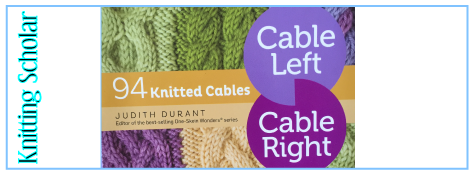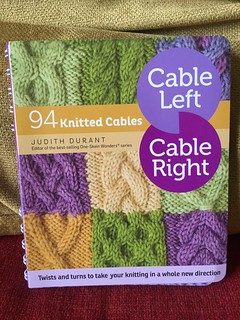First, the facts:
Title: Cable Left Cable Right: Twists and turns to take your knitting in a whole new direction
Author: Judith Durant
Published by: Storey Publishing
Pages: 216
Type: Cable stitch patterns
Chapters:
1. Cable Basics
2. Simple Cables
3. Angles and Curves
4. Braids and Pretzels
5. Fillers, Ribbings, and Allover Patterns
6. Dressing Up Your Cables
7. Design Considerations
The In-Depth Look:
How can you not love a good stitch dictionary, especially one devoted to cables?
I love knitting cables. I find twisting and manipulating my stitches while I knit makes a project more interesting and fun to do, but I also love the intricate designs that makes. Watching a cable snake in and out, twist around, duck behind other strands in a braid … love that, in the same way I love detailed knot-work.
It’s simple enough to just follow a pattern, of course–to let someone else do the work of putting cables together for a sweater or an afghan project, but knowledge is power. (This seems to be a theme for Judith Durant’s books of late.)
If you know how a cable is “put together” and know how to pair them or match them, how to line them up so that different cables work well together, or support each other, it makes playing with them that much more fun.
To that end, the book gives you basic cable instructions, and then basic patterns for simple cables, rules on tweaking them, and how to do sharp angles or gentle curves. You learn about braids and pretzels, as well as filler stitches … and then how to dress them up with texture or beads. Finally, she addresses how to put all these lovely cables together in a design that will be balanced and will work.
And meanwhile, you have all these lovely, color-coordinated pictures to browse through. (Let’s face it, that’s half the fun of stitch dictionaries, isn’t it?) Not that this is strictly a stitch dictionary–because while it gives you the stitch patterns, it also gives you the tools you need to play with them.
All 94 of the cables have charted instructions, not line-by-line written ones, but this shouldn’t deter you. In fact, for cables, I think charts are much easier to follow than written instructions. In this case, all the chart graphics are explained in the first chapter, so that you always have a reference to look at if you’ve forgotten a particular symbol, but otherwise, the cables are all displayed and explained via easy-to-read charts.
Knowledge is power, after all. Like Judith says in the introduction, “Knit and cable on.”
You can find this book at your local bookshop or you can buy it direct from Amazon!
Want to see bigger pictures? Click here.

This review copy was kindly donated by . Thank you!
Other posts for this author:


